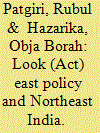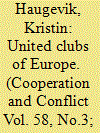|
|
|
Sort Order |
|
|
|
Items / Page
|
|
|
|
|
|
|
| Srl | Item |
| 1 |
ID:
111550


|
|
|
|
|
| Publication |
2012.
|
| Summary/Abstract |
Since 1960, Latin American attempts at regionalism have undergone distinct phases. More notably, they have tended to diverge across space, gradually giving birth to separate blocs that seem to be tearing South, Central and North America apart. Additionally, within and across these regions several overlapping projects coexist. This article focuses on the dynamics of segmented and overlapping regionalism in order to describe what they look like, analyse how they articulate with one another, and explain why member states have pushed for such a messy outcome. This situation, linked to the evolution of the global context, might be indicating that regionalism in Latin America has reached its peak, beyond which it may be difficult to achieve further progress. Two conclusions are elicited: first, economic integration is becoming a geographically diffused phenomenon rather than a regional one; second, regionalism is still a compelling foreign policy but its causes, goals and outcomes are no longer what they used to be.
|
|
|
|
|
|
|
|
|
|
|
|
|
|
|
|
| 2 |
ID:
190750


|
|
|
|
|
| Summary/Abstract |
The underdevelopment of Northeast India is quite often explained in terms of economic isolation primarily on account of its geographical peripherality. To address this challenge, a new imagination, through the Look (Act) East Policy has been proposed. This approach, makes India’s Northeast the centre of a unified economic, physical and social space through its integration with the trans-border neighbouring regions. In this article, an attempt has been made to examine the logic of developing an ‘extended Northeast’ and how it has been sought to be realized. The article argues that the actualization of this proposed integrated space is ridden with serious difficulties and the internal fragmentation of Northeast India and the exceptional rules and administrative arrangement that are in place in the region along with the geopolitical compulsion of India may act as significant barriers in this regard. And most importantly there are apprehensions that the proposed integrated space may lead to the appropriation of resources of the Northeast by the corporate houses without benefiting the people of the region.
|
|
|
|
|
|
|
|
|
|
|
|
|
|
|
|
| 3 |
ID:
193017


|
|
|
|
|
| Summary/Abstract |
This article makes the case for integrating informal, social and minilateral dynamics in analyses of ‘differentiated integration’ in the European Union (EU) context. In EU studies, differentiated integration has mainly served as an analytical lens for studying variation in states’ degree of formalized commitment to the European integration project or in organizational decision-making procedures across policy areas. While this focus has generated important analytical and empirical insights, three dimensions tend to be lost when limiting the study of differentiated integration to negotiated outcomes manifest in legal documents and decision-making procedures. First, informal processes of integration precede and concur with formal ones. Second, European integration is an inherently social process, and member states integrate with the EU identity-building project in different ways and to different degrees. Third, member states enjoy heterogeneous social ties with one another, routinely forming informal bi- and minilateral coalitions in everyday decision-shaping processes. More knowledge about these informal and social dynamics can give us a better understanding of how differentiated integration manifests itself in practice and where the European integration process is heading. The theoretical argument is buttressed by data from the 2020 European Council of Foreign Relations’ ‘Coalition Explorer’ survey, showing how partner preferences within the EU continue to reflect stable social sub-orders.
|
|
|
|
|
|
|
|
|
|
|
|
|
|
|
|
|
|
|
|
|